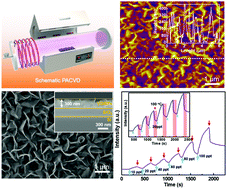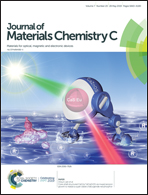Controllable growth of vertically oriented graphene for high sensitivity gas detection†
Abstract
This paper sheds light on the effects of process parameters on the low-temperature growth of vertical graphene nano-petals (VGNPs) by plasma-assisted chemical vapor deposition (PACVD) at 550 °C without the presence of any catalyst or post-transfer treatment. The parameters include substrate temperature, plasma power and growth time. The significant influence of these variable parameters reveals the morphological evolution, growth rate and quality of VGNPs. Furthermore, the defect-guided growth mechanism of the VGNPs is discussed in detail. The as-grown VGNPs possess high hydrophobicity (water contact angle: 137°) due to their unique physicochemical properties, ultra-high specific surface area, exposed sharp edges and non-stacking three-dimensional geometry. This study provides a methodology for optimizing the conditions to prepare VGNPs. A gas sensor exhibits superior sensitivity due to high specific surface area and a parts-per-trillion (ppt) level of NH3 detection capabilities and is directly manufactured on a SiO2 substrate with VGNPs. Moreover, Joule-heating expels molecules by physisorption from the vertical surface leading to fully reversible and low-power operation. Our study may provide new insights into the improved design of graphene-based sensing applications.



 Please wait while we load your content...
Please wait while we load your content...